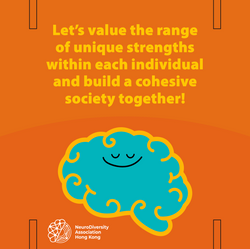 |  |  |  |
|---|---|---|---|
 |
Neurodiversity
Myths
There are many myths about neurodiversity. While the list may change, there are a few common misconceptions and they are particularly important to be addressed.
1
"Neurodiversity" is only for a subset of our population.
Those unfamiliar with the concept of neurodiversity may often misunderstand it as either a mere perspective or a platform for individuals with neurological conditions to voice their opinions. However, the true essence of neurodiversity is far more profound.
At its core, neurodiversity recognizes the remarkable diversity of the human mind and cognitive abilities. It is a movement that emphasizes the inherent worth and rights of neurodivergent individuals as equal and valuable members of society. In fact, neurodiversity can be seen as a subset of the broader notion of "biodiversity" - the rich tapestry of life on our planet.
Far from a narrow perspective or a platform for a select few, the neurodiversity movement represents a holistic understanding of the richness and complexity of the human experience. It is a powerful call to embrace the diversity of our minds and to create a more equitable and supportive world for all.
2
“Neurodiversity Movement” dismisses challenges
The neurodiversity movement does not deny or minimize the very real difficulties that come with neurological differences. It recognizes that neurodivergent individuals often face significant struggles in various aspects of their lives and societal barriers that are often designed and built for neuromajorities. Rather than ignoring the challenges, the neurodiversity advocates for a shift in perspective and aims to reframe them within a strength-based and empowering framework. It encourages society to focus on the unique strengths and abilities of neurodivergent individuals, rather than solely on their deficits or difficulties.
Proponents of the neurodiversity movement often identify the significant societal barriers in education, employment, healthcare, and social settings and address these systematic challenges rather than coping within the deficits framework.
3
“Neurodiversity” does not apply to “High Functioning”
The term "high functioning" is often used to describe neurodivergent individuals who, on the surface, may appear to be managing well. The myth that “neurodiversity” does not apply to “high-functioning” individuals is a misconception because, and just because a neurodivergent individual can make friends, communicate verbally with ease, or perform well academically, it does not mean they are not struggling underneath with sensory processing, emotional regulation, social navigation, attention, executive functioning, etc. The “high-functioning” label often downplays the complex and nuanced experiences of neurodivergent individuals, denying their struggles and the essential understanding they need to thrive. Neurodiversity is a spectrum, therefore, all neurological variations are considered as part of the diversity under this umbrella.
